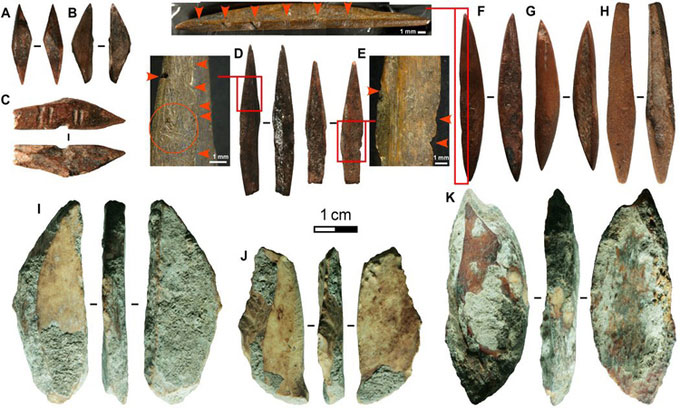The 48,000-year-old arrowhead is detected by animal bones
Traces of sharp objects found at the Fa-Hien Lena cave have revealed, they are likely the arrowheads used by ancient people to hunt.
An international team of scientists discovered 130 sharp objects made primarily of monkey bones at Fa-Hien Lena cave , Sri Lanka, IFL Science reported on June 12. All were scratched, scratched, and had different markings that matched damage from hunting. The team thinks that the oldest of these sharp objects are for hunting monkeys. In addition, the fact that they have increased in length over time suggests that later generations hunt for larger animals, such as deer or pigs.

Numerous ancient arrowheads are found in the Fa-Hien Lena cave. (Photo: Trendsmap).
Notches on sharp objects indicate they used to be attached to lamination. Based on size and weight, the scientists ruled out the ability of the ancients to use the bellows to launch these weapons. They judged that they were most likely arrowheads. The oldest of them dated to 48,000 years, is the oldest bow and arrow weapon found outside Africa . The new study appears in the journal Science Advances.
Earlier, the earliest evidence of high-speed launch weapons in South Asia is the 32,000-year-old arrowheads discovered in Sarawak, Borneo. The authors of the new study also commented that the arrowhead at Fa-Hien Lena cave is very similar to them. The main difference is that the weapons in Sarawak are made from the bones of larger mammals.
The team also discovered many tools that the ancients used to process animal skin and vegetable fibers, forming clothes. With the warm temperatures in the rainforest, residents here don't need to wear fur to keep warm. Instead, experts say they use it as a protective layer against disease-carrying insects.
In addition to weapons and clothing-making tools, the team also found decorative beads and shells of marine animals, most likely used to exchange like money. The appearance of marine-originated items is particularly interesting. This shows that the goods exchange network connects the forest dwellers with the coastal residents.
The new research contributes to creating a detailed picture of the complex technical and social levels of the first inhabitants of South Asia's forests, revealing how they survive and thrive in challenging environments. this.
- Deer survive for years with arrows across the ribs
- Flowers made from animal bones
- Detecting animal bones used in divination ritual in Japan
- Find ancient telescopes made of animal bones
- Connect the bones of the screw made from ... human bones
- Fabrication of fabric fibers from animal skin and bones? How?
- Finding fossil animal bones in Lao Cai
- Ancient worms eat animal bones
- How did the ancients store and consume animal bone marrow?
- Graveyard mammoth under the Volga river
- Interesting facts about bones are not well known
- Playing football helps strong bones
 Discovered an ancient centipede fossil 99 million years old
Discovered an ancient centipede fossil 99 million years old Discovered bat-like dinosaurs in China
Discovered bat-like dinosaurs in China Discovered a 200-year-old bronze cannon of the coast
Discovered a 200-year-old bronze cannon of the coast Discover 305 million-year-old spider fossils
Discover 305 million-year-old spider fossils